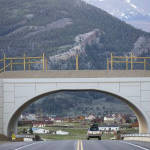Land Matters: Month of the beaver
Colorado Headwaters Land Trust

Jeremy D. Krones/Colorado Headwaters Land Trust
June was the month of the beaver for me. Castor canadensis, the North American beaver.
The month was bookended with presentations about the Kawuneeche Valley Ecosystem Restoration Collaborative. The first was in late May at the State of the River, an annual update on the Colorado River. The Kawuneeche Valley is at the start of the river and over the last 150 years has been degraded by human impact, which drives away wildlife and can reduce the health of the river and valley.
The collaborative will work on regrowing vegetation, recovering wildlife habitat and restoring a healthy water system – hopefully with the help of beavers. Beavers are a native species and are ecosystem engineers, meaning they have a direct role in managing the natural environment.
While many animals just find a nice place to live and settle down, beavers make their own nice places by altering their surroundings. They maintain riparian environments by controlling the waterway with dams and lodges. But beavers are only attracted to areas with the right amount of flowing water, timber and space.

We can’t just move beavers from one place to another. But if we improve the area and make it attractive to beavers, they will come and continue building a healthy, stable environment for themselves and many other species.
My second beaver event was at Headwaters Book Club, a project by Colorado Headwaters Land Trust and Headwaters Trails Alliance. For our June discussion the club met at the Headwaters River Journey (different groups, same headwaters) to discuss “Eager: The Surprising, Secret Life of Beavers and Why They Matter,” by Ben Goldfarb. The book takes us through the historical, ecological and social roles beavers play in our world, and what it might take to bring them back.
Throughout most of American history beavers were valued for their fur and disliked as competition on the landscape, since we also are ecosystem engineers. Ironically, early American farmers preferred the nutrient-rich soils around beaver ponds, but ended up driving away the beavers. Now beavers are understood to be vital to environmental stability and are being reintroduced around the country.
Next, I was in South Park on a field trip with Colorado Open Lands, a state-wide land trust. They are restoring riparian areas in that region, like the Kawuneeche Valley project intends to do here. We visited a site just starting restoration and an area a few years under restoration. The differences were outstanding.
The first stream was straight and slow, in a relatively dry valley with little biodiversity. You might not even know there was a stream if you weren’t standing next to it. The second stream was meandering, fast and teeming with life.

There was also a difference in human engagement. The first site was fine for hiking, but nothing spectacular. The second, however, had fishermen scouting the creek and cattle grazing nearby, not to mention campers filling every spot along the road.

My month ended with the second Kawuneeche Valley Ecosystem Restoration Collaborative presentation, at the Rivers Illustrated exhibit in the Kawuneeche Visitor Center.
As we continue to learn what stable ecosystems look like and understand that we all benefit from them, the beaver is a good friend to have.
If beavers had a slogan, it would be Gandhi’s famous quote, “Be the change you want to see in the world.” They want to see a healthy home, so they’re going to build it. We should help.

Jeremy D. Krones is the executive director of Colorado Headwaters Land Trust. The land trust’s mission is to conserve and steward the open lands and natural character of the headwaters of the Colorado River in partnership with the local community, and works with private landowners throughout Grand County to conserve their land in perpetuity. To learn more, please call (970) 887-1177 or email: jeremy@coloradoheadwaterslandtrust.org.

Support Local Journalism

Support Local Journalism
The Sky-Hi News strives to deliver powerful stories that spark emotion and focus on the place we live.
Over the past year, contributions from readers like you helped to fund some of our most important reporting, including coverage of the East Troublesome Fire.
If you value local journalism, consider making a contribution to our newsroom in support of the work we do.









